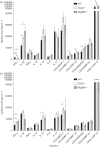Highly pathogenic avian influenza A H5N1 and pandemic H1N1 virus infections have different phenotypes in Toll-like receptor 3 knockout mice
- PMID: 24878639
- PMCID: PMC4135086
- DOI: 10.1099/vir.0.066258-0
Highly pathogenic avian influenza A H5N1 and pandemic H1N1 virus infections have different phenotypes in Toll-like receptor 3 knockout mice
Abstract
Toll-like receptors (TLRs) play an important role in innate immunity to virus infections. We investigated the role of TLR3 in the pathogenesis of H5N1 and pandemic H1N1 (pH1N1) influenza virus infections in mice. Wild-type mice and those defective in TLR3 were infected with influenza A/HK/486/97 (H5N1) or A/HK/415742/09 (pH1N1) virus. For comparison, mice defective in the gene for myeloid differential factor 88 (MyD88) were also infected with the viruses, because MyD88 signals through a TLR pathway different from TLR3. Survival and body weight loss were monitored for 14 days, and lung pathology, the lung immune-cell profile, viral load and cytokine responses were studied. H5N1-infected TLR3(-/-) mice had better survival than H5N1-infected WT mice, evident by significantly faster regain of body weight, lower viral titre in the lung and fewer pathological changes in the lung. However, this improved survival was not seen upon pH1N1 infection of TLR3(-/-) mice. In contrast, MyD88(-/-) mice had an increased viral titre and decreased leukocyte infiltration in the lungs after infection with H5N1 virus and poorer survival after pH1N1 infection. In conclusion, TLR3 worsens the pathogenesis of H5N1 infection but not of pH1N1 infection, highlighting the differences in the pathogenesis of these two viruses and the different roles of TLR3 in their pathogenesis.
© 2014 The Authors.
Figures





Similar articles
-
CLEC5A-Mediated Enhancement of the Inflammatory Response in Myeloid Cells Contributes to Influenza Virus Pathogenicity In Vivo.J Virol. 2016 Dec 16;91(1):e01813-16. doi: 10.1128/JVI.01813-16. Print 2017 Jan 1. J Virol. 2016. PMID: 27795434 Free PMC article.
-
Lethal dissemination of H5N1 influenza virus is associated with dysregulation of inflammation and lipoxin signaling in a mouse model of infection.J Virol. 2010 Aug;84(15):7613-24. doi: 10.1128/JVI.00553-10. Epub 2010 May 26. J Virol. 2010. PMID: 20504916 Free PMC article.
-
Increased pathogenicity of a reassortant 2009 pandemic H1N1 influenza virus containing an H5N1 hemagglutinin.J Virol. 2011 Dec;85(23):12262-70. doi: 10.1128/JVI.05582-11. Epub 2011 Sep 14. J Virol. 2011. PMID: 21917948 Free PMC article.
-
The use of nonhuman primates in research on seasonal, pandemic and avian influenza, 1893-2014.Antiviral Res. 2015 May;117:75-98. doi: 10.1016/j.antiviral.2015.02.011. Epub 2015 Mar 5. Antiviral Res. 2015. PMID: 25746173 Free PMC article. Review.
-
Innate immune responses to influenza A H5N1: friend or foe?Trends Immunol. 2009 Dec;30(12):574-84. doi: 10.1016/j.it.2009.09.004. Epub 2009 Oct 26. Trends Immunol. 2009. PMID: 19864182 Free PMC article. Review.
Cited by
-
Avian Toll-like receptor 3 isoforms and evaluation of Toll-like receptor 3-mediated immune responses using knockout quail fibroblast cells.Poult Sci. 2020 Dec;99(12):6513-6524. doi: 10.1016/j.psj.2020.09.029. Epub 2020 Sep 28. Poult Sci. 2020. PMID: 33248566 Free PMC article.
-
The role of respiratory epithelium in host defence against influenza virus infection.Biomed J. 2018 Aug;41(4):218-233. doi: 10.1016/j.bj.2018.08.004. Epub 2018 Sep 10. Biomed J. 2018. PMID: 30348265 Free PMC article. Review.
-
Advancements in Host-Based Interventions for Influenza Treatment.Front Immunol. 2018 Jul 10;9:1547. doi: 10.3389/fimmu.2018.01547. eCollection 2018. Front Immunol. 2018. PMID: 30042762 Free PMC article. Review.
-
Proteomic analysis reveals down-regulation of surfactant protein B in murine type II pneumocytes infected with influenza A virus.Virology. 2015 Sep;483:96-107. doi: 10.1016/j.virol.2015.03.045. Epub 2015 May 15. Virology. 2015. PMID: 25965799 Free PMC article.
-
Toll-like receptor 3 (TLR3) regulation mechanisms and roles in antiviral innate immune responses.J Zhejiang Univ Sci B. 2021 Aug 15;22(8):609-632. doi: 10.1631/jzus.B2000808. J Zhejiang Univ Sci B. 2021. PMID: 34414698 Free PMC article. Review.
References
-
- Chan R. W., Yuen K. M., Yu W. C., Ho C. C., Nicholls J. M., Peiris J. S., Chan M. C. (2010). Influenza H5N1 and H1N1 virus replication and innate immune responses in bronchial epithelial cells are influenced by the state of differentiation. PLoS ONE 5, e8713 10.1371/journal.pone.0008713 - DOI - PMC - PubMed
Publication types
MeSH terms
Substances
Grants and funding
LinkOut - more resources
Full Text Sources
Other Literature Sources
Medical

